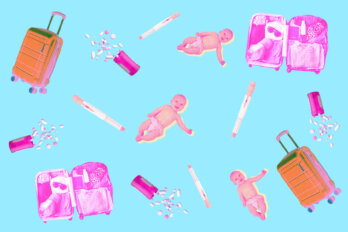Last summer, scrolling through Instagram, I noticed that some photographers I followed were posting images tagged #VirtualShoot or #FaceTimePhotoshoot to document their time in quarantine. For many of these virtual shoots, photographers were framing screenshots through platforms such as Zoom and FaceTime. In one photo, the model, dressed in a red bodysuit, red thigh-high boots, and a feather boa, emerges from a pool. In another, a plus-size model in a red dress poses on a rooftop. The most intimate images I found were of couples. Something about their close embraces felt personal and vulnerable, as if I were right there with them.
In June, I booked my own photoshoot with Shoog, a fat-positive Florida-based photographer who has used their images to showcase plus-size bodies in all their glory. During the thirty-minute session, they asked me to shape my body into various poses and carefully adjust the window blinds and the screen of my laptop for lighting. Shoog’s followers have come to know them for their signature belly-jiggle Boomerangs, in which they capture their subjects grabbing their bellies and shaking them; the images are then stitched together into a mini video, similar to a GIF. Shoog asked if I would be interested in participating, and I gleefully obliged. When I received the images, a few days later, I couldn’t believe that I was the person in them: smiling harder than she ever had, proudly showing off her naked stomach and thighs in a way she had never done before, and indulging in a bit of fat vanity. But, most of all, the person in these photos looked peaceful. It’s hard to describe, but it was something that she had always longed for, and it was beautiful.
Before the pandemic forced me to isolate from my family and friends, I had always felt some pressure, whether internal or external, to look a certain way. I never felt that I could fully love the parts of my body that Shoog highlighted. Sure, I had modelled before, but I was never this vulnerable. It took months of relative isolation to change that.
My daily beauty routine largely remained unchanged in the early days of the COVID-19 pandemic: each morning, I would sit down in front of my vanity mirror, which was outfitted with adjustable LED lights, and carefully apply layers of foundation, highlighter, and colour-correcting liquid primer for dark undereye circles, covering my imperfections one by one. Then, like the character Cher in Clueless, I’d stand before my closet and try to piece together an outfit that would catch everyone’s attention—no small feat as a fat woman. For as long as I could remember, this routine had felt like a political statement or an act of resistance. Navigating the world in a fat body, I always felt I was trying to reconceptualize what society deemed beautiful. The clothes I wore gave me a sense of security: they were an element of my appearance I could control.
But, like so many others navigating the pandemic last spring, I was no longer leaving my house every day and, as a result, my relationship to clothes and makeup started to change. I found myself questioning whether I really needed makeup and the best outfit to feel beautiful. To complicate matters, I was still facing the pressure of maintaining my appearance in digital spaces for work or even social commitments. Claire Carter, associate professor in the University of Regina’s department of gender, religion, and critical studies, says that, because so many of our interactions are now online using video-conferencing software, we regularly have to confront what’s known as the normative gaze of our own bodies—how we internalize a heteronormative idea of the ideal body and measure ourselves against it—which, for many individuals, can add undue stress in an already difficult time. “Having to view yourself constantly,” Carter says, can have a negative impact on mental health. “It’s very distracting and does kind of feed into the ways that we are told we’re supposed to look.”
Caitlin Chee, a nonbinary performer from Toronto, tells me they’ve tried to limit their use of online video platforms like Zoom and Twitch, both of which had heightened their self-consciousness. “I would find myself staring at myself while I’m talking,” they said. “If you were in person, you wouldn’t be doing that.”
As the pandemic and various public health restrictions stretched into months, I wondered what, if anything, this era might change about our society’s onerous beauty standards—and my own. I realized that, after so many years of using clothes and makeup as a shield, I had no idea what it would look like to look good just for me.
In the first four months of the pandemic, Carter observed two trends taking place: people who felt a huge release from their typical beauty rituals and those who felt the need to keep them up. Sephora’s online sales in the US were reportedly up 30 percent in 2020 versus 2019, while in China, revenues for other beauty-industry retailers (including Amazon) rose 20 to 30 percent overall last year. And, with limited access to beauty salons and hairdressers, many Instagram and TikTok users shared DIY beauty tricks, from all-natural facial toner to hair dye made by soaking scraps of fluorescent Post-it Notes in hot water, which leaches out the pigment.
At the same time, brands such as Lululemon and Uniqlo reported surging sales of athleisure wear as remote work rendered workplace dress codes obsolete. On Instagram, Tiktok, and other social media platforms, celebrities including Kylie Jenner, JoJo Siwa, and Ariana Grande shared posts in which they claimed to embrace their new natural looks in quarantine. Hannah McCann, a senior lecturer at the University of Melbourne who specializes in critical femininity studies, cautions that posts exhorting so-called natural beauty uphold the gender binary and the notion that faces, hair, and bodies unaltered by cosmetics, styling products, or plastic surgery are “more authentic.” “This culture around the idea of natural beauty, what it does is it marginalizes a lot of people whose expressions might be seen as more kind of hyperfeminine or sexualized femininity,” she says.
Among those affected are many trans and nonbinary folks who rely heavily on gender-validating beauty practices to feel safe and affirmed in their own bodies, and for whom giving up these practices and living in sweatpants is not necessarily a luxury. Carter says many may be harder hit by the closure of beauty services such as hairdressers and aestheticians and retail spaces such as makeup counters. Isolation and restricted access to beauty services may also stir up bouts of body dysmorphia, or being consumed by relentless, intrusive thoughts about one’s appearance, as their bodies begin to change in ways they can no longer control.
For trans people, Chee says, certain beauty products and services help them affirm their gender identities—and, in some cases, make them feel more accepted by society. “For some people, that is about safety,” they say. “But a lot of it is also just, Will people be mean to me? Or will this affect my career because people will have a bias toward what we find attractive?”
While I don’t equate my own personal experience with Chee’s, we both agree that the thought of making ourselves presentable to the webcam day after day, on top of dealing with the various anxieties the pandemic has wrought, is exhausting. Yet I still wanted to feel that I was maintaining my appearance in some way. A few months into the pandemic, I realized that something about my beauty routine—or my expectations for how I should appear—had to change. And I wasn’t alone: in a March 2020 The Atlantic article about shifting beauty practices, journalist Amanda Mull noted that even simple routines helped many of those she interviewed maintain their sense of self and identity. “In a pandemic,” Mull writes, “you figure out which ones are worth the trouble.”
At first, the thought of not wearing makeup made me uncomfortable because, for so long, wearing a bold shade of lipstick or shimmering pop of highlighter had been a confidence booster. It still is. But, slowly, I had to tell myself it was okay to be without these things. The world shaped by the pandemic didn’t eradicate the impossible beauty standards I’ve always battled with, but it did offer me an opportunity to reset my own expectations.
That meant I had to embrace my bare skin, my stretch marks, my hormonal acne. I slowly stopped using makeup and took up more ritualistic practices, including washing my face with a facial-cleansing device that, oddly, some people have compared to a vibrator. Taking on more complex skincare plans acted as a comforting force for my own mental health. Long gone are the days when I obsessed about colour-correcting those dark undereye circles. Now, I find myself carefully applying SPF 50 sunscreen to help reduce potential damage to my skin from my computer’s blue light.
In the past, I’d spent time and energy covering up my imperfections. Now, I just wanted to find a way to embrace them. Which is how I eventually fell upon the idea of facing down the webcam on my own terms.
After my session with Shoog, I hopped onto FaceTime for a second photoshoot, this time with Emma Wondra, a body-positive queer Portland-based photographer who creates magical fantasy lands out of ordinary settings. Wondra walked me through my apartment and helped me turn it into a sultry boudoir backdrop. We laughed as they snapped photos of me in my retro-looking bathtub while I awkwardly joked about my loofah to break the tension. Wondra took me in all my dorky splendour and turned each photo into something glam, sensual, and cool.
The photoshoots, while healing, didn’t eradicate my self-criticism forever. The thing about body image is that there are good days and there are bad days. Over the past year, I’ve come to recognize that, for too long, I kept consciously and subconsciously altering myself and the way I looked just to be beautiful by society’s standards rather than focusing on what made me feel good.
I don’t know whether I’ll be able to hold on to this revelation whenever we ease back into in-person gatherings and I once again face the pressure of being out in public. No matter what happens, at the very least, I’ll have a belly-jiggle Boomerang to remind myself of what it felt like to find, even briefly, a moment of inner peace with myself and my body.




